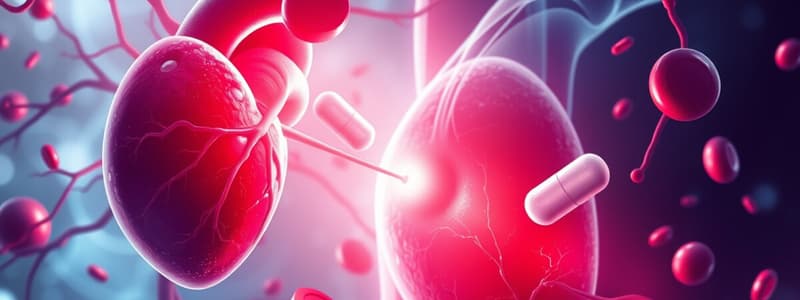Podcast
Questions and Answers
What does 'hem-' mean?
What does 'hem-' mean?
blood
What does '-stasis' mean?
What does '-stasis' mean?
to stop
What is hemostasis?
What is hemostasis?
the stopping of blood flow
Hemostasis is achieved once a blood clot is formed.
Hemostasis is achieved once a blood clot is formed.
What is the process of blood changing from a liquid to a gel called?
What is the process of blood changing from a liquid to a gel called?
What are the two pathways activated in response to tissue injury?
What are the two pathways activated in response to tissue injury?
What does fibrinogen form?
What does fibrinogen form?
Which of the following drugs is used to prolong bleeding time?
Which of the following drugs is used to prolong bleeding time?
What is the antidote for heparin?
What is the antidote for heparin?
What is one contraindication for IM administration of heparin?
What is one contraindication for IM administration of heparin?
How long can the anticoagulant activity of warfarin take to reach maximum effect?
How long can the anticoagulant activity of warfarin take to reach maximum effect?
Flashcards are hidden until you start studying
Study Notes
Hemostasis
- "Hemostasis" combines "hem-", meaning blood, and "-stasis", meaning to stop; it refers to the stopping of blood flow.
- A vital mechanism that protects the body from excessive blood loss following external or internal injuries.
- The process culminates in the formation of a blood clot, preventing severe hemorrhage.
- Multiple clotting factors are activated through a sequential cascade of events during hemostasis.
Basic Steps in Hemostasis
- Coagulation, or clotting, transforms blood from liquid to gel, creating a blood clot.
- The Coagulation Cascade is a series of steps triggered by tissue injury, wherein each step activates the subsequent one, ultimately forming a clot.
- The Intrinsic Pathway is activated in response to internal blood vessel injury.
- The Extrinsic Pathway occurs when blood leaks from vessels into tissue spaces.
- Fibrinogen (clotting factor I) converts to fibrin, which binds platelets and plasma proteins to form a hemostatic plug.
- Prothrombin (clotting factor II) activates thrombin, which plays a crucial role in the clotting process.
Anticoagulants
- Anticoagulants are medications that prolong bleeding time to prevent thrombi formation or expansion.
- They impart a negative charge to platelets, inhibiting their aggregation.
- The process of clot breakdown is known as fibrinolysis.
Heparin Sodium
- Enhances the action of antithrombin III, a plasma protein that inactivates thrombin and other procoagulant enzymes, thereby inhibiting coagulation.
- Administered via IV for rapid action; prevents the formation of fibrin clots within minutes.
- Heparin is often referred to as unfractionated heparin, differentiating it from low-molecular-weight heparins (LMWHs).
- LMWHs are modified heparin with a more specific action towards active Factor X, longer half-life, and a more stable response than unfractionated heparin.
Enoxaparin Sodium
- A type of low-molecular-weight heparin that operates similarly to heparin, but is more selective in its inhibition.
- Demonstrates a duration of action that is two to four times longer than heparin.
- Preferred for various clotting disorders and post-surgical DVT prevention due to a lower risk of thrombocytopenia.
Nursing Interventions for Heparin Sodium
- Monitor activated Partial Thromboplastin Time (aPPT) and platelet counts.
- Administer subcutaneously in the abdomen at a 90º angle using a 25-28 G needle; do not aspirate or massage after injection.
- IM administration is contraindicated to reduce bleeding risk.
- The normal aPPT range is 20 to 40 seconds; therapeutic levels should be maintained at 1.5 to 2.5 times the normal value during continuous infusion.
- aPPT should be measured every 4 to 6 hours initially, and then daily thereafter.
- The antidote for heparin overdose is Protamine Sulfate.
Warfarin Sodium
- Warfarin inhibits the hepatic synthesis of coagulation factors II, VII, IX, and X.
- Its anticoagulant effect may take several days to achieve maximum efficacy.
- Warfarin prolongs clotting times, specifically Prothrombin Time (PT) and International Normalized Ratio (INR).
Studying That Suits You
Use AI to generate personalized quizzes and flashcards to suit your learning preferences.




